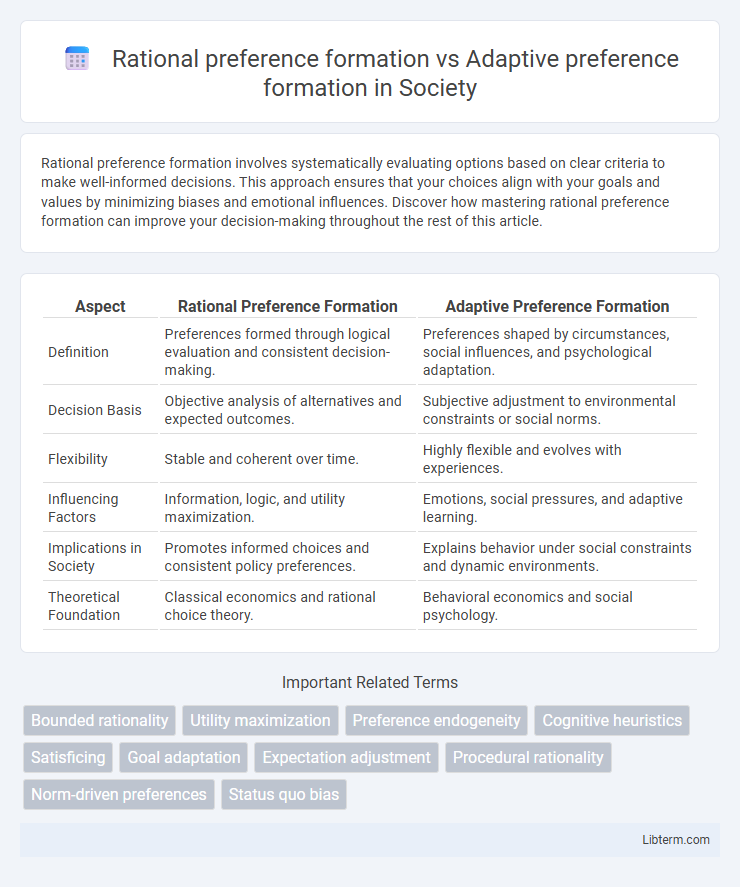Rational preference formation involves systematically evaluating options based on clear criteria to make well-informed decisions. This approach ensures that your choices align with your goals and values by minimizing biases and emotional influences. Discover how mastering rational preference formation can improve your decision-making throughout the rest of this article.
Table of Comparison
| Aspect | Rational Preference Formation | Adaptive Preference Formation |
|---|---|---|
| Definition | Preferences formed through logical evaluation and consistent decision-making. | Preferences shaped by circumstances, social influences, and psychological adaptation. |
| Decision Basis | Objective analysis of alternatives and expected outcomes. | Subjective adjustment to environmental constraints or social norms. |
| Flexibility | Stable and coherent over time. | Highly flexible and evolves with experiences. |
| Influencing Factors | Information, logic, and utility maximization. | Emotions, social pressures, and adaptive learning. |
| Implications in Society | Promotes informed choices and consistent policy preferences. | Explains behavior under social constraints and dynamic environments. |
| Theoretical Foundation | Classical economics and rational choice theory. | Behavioral economics and social psychology. |
Introduction to Preference Formation
Preference formation involves how individuals develop choices based on available options and personal values. Rational preference formation assumes consistent, stable preferences derived from deliberate evaluation of information and outcomes, optimizing decision-making. Adaptive preference formation suggests preferences evolve in response to situational constraints and experiences, allowing flexibility but often leading to satisficing rather than optimal decisions.
Defining Rational Preference Formation
Rational preference formation involves individuals making choices based on consistent, stable, and well-ordered preferences derived from logical evaluation of available options. It assumes decision-makers maximize utility by systematically weighing benefits and costs to achieve optimal outcomes. This model contrasts with adaptive preference formation, where preferences evolve in response to constraints and past experiences rather than fixed criteria.
Understanding Adaptive Preference Formation
Adaptive preference formation occurs when individuals adjust their desires and choices based on their circumstances, especially in the face of limitations or changing environments. This concept challenges the rational preference formation model, which assumes stable and consistent preferences formed through objective evaluation. Understanding adaptive preference formation highlights how context and experience dynamically shape preferences, reflecting psychological and social influences rather than purely rational decision-making.
Historical Perspectives on Preference Theory
Historical perspectives on preference theory distinguish Rational preference formation as based on consistent, transitive choices reflecting stable utility maximization, rooted in classical economics and decision theory since the 18th century. Adaptive preference formation emerged in the late 20th century, emphasizing how preferences evolve based on social, psychological, and environmental constraints, challenging the assumption of fixed preferences. Key figures like Amartya Sen and Herbert Simon advanced this view by highlighting the role of bounded rationality and adaptive mechanisms in shaping individual choice over time.
Psychological Foundations of Rational Preferences
Psychological foundations of rational preferences emphasize coherent, consistent decision-making guided by stable beliefs and logical deliberation, aligning with utility maximization principles in economic theory. Rational preference formation involves evaluating options based on well-defined criteria and anticipated outcomes, reflecting cognitive processes like reasoning, memory, and judgment. Conversely, adaptive preference formation arises from contextual influences and psychological needs, where preferences evolve from experiences, social conditioning, or perceived constraints rather than fixed rational evaluations.
Environmental Influences on Adaptive Preferences
Adaptive preference formation is heavily influenced by environmental factors such as social norms, cultural context, and resource availability, leading individuals to adjust their desires based on external constraints. In contrast, rational preference formation assumes stable, consistent preferences independent of context, focusing on logical evaluation and maximization of utility. Understanding environmental influences on adaptive preferences highlights how changing conditions shape decision-making and preference evolution over time.
Comparing Rational and Adaptive Preference Models
Rational preference formation models assume individuals have stable, consistent preferences derived from complete information and logical evaluation, enabling predictable decision-making patterns. Adaptive preference models focus on preferences evolving in response to contextual factors, limited information, and psychological constraints, highlighting flexibility and context-dependence in choice behavior. Comparing these models reveals rational approaches prioritize internal consistency and utility maximization, whereas adaptive models emphasize learning, habituation, and environmental influence in shaping preferences dynamically.
Implications for Decision-Making Processes
Rational preference formation assumes individuals make decisions by consistently evaluating options based on stable, well-defined preferences, leading to predictable outcomes in decision-making processes. Adaptive preference formation suggests preferences evolve based on contextual constraints and past experiences, highlighting the fluidity of choices and the role of environmental factors in shaping decisions. Understanding these approaches influences the design of choice architectures, improving decision-making accuracy by accounting for both stable and dynamic preference patterns.
Real-World Examples of Preference Formation
Rational preference formation involves individuals making decisions based on consistent, well-informed evaluations, as seen in consumers researching product features and pricing before purchasing electronics. Adaptive preference formation occurs when individuals adjust their preferences due to constraints or limited options, exemplified by job seekers settling for positions below their qualifications after prolonged unemployment. Real-world instances reveal that while rational preferences drive deliberate choices, adaptive preferences emerge as responses to environmental pressures and restricted alternatives.
Future Directions in Preference Research
Future directions in preference research emphasize integrating Rational Preference Formation, which assumes stable, well-defined preferences based on coherent information processing, with Adaptive Preference Formation, where preferences evolve through experience and contextual changes. Advanced modeling techniques and neuroeconomic studies aim to capture the dynamic interplay between cognitive consistency and environmental adaptability in decision-making processes. Enhancing predictive accuracy in consumer behavior and policy design relies on understanding how rational deliberation and adaptive learning coalesce over time.
Rational preference formation Infographic

 libterm.com
libterm.com